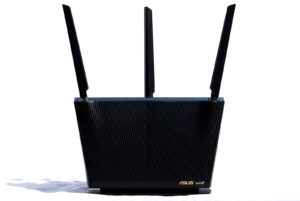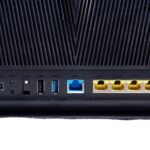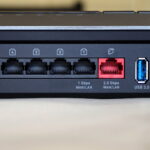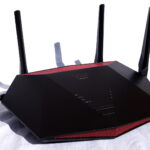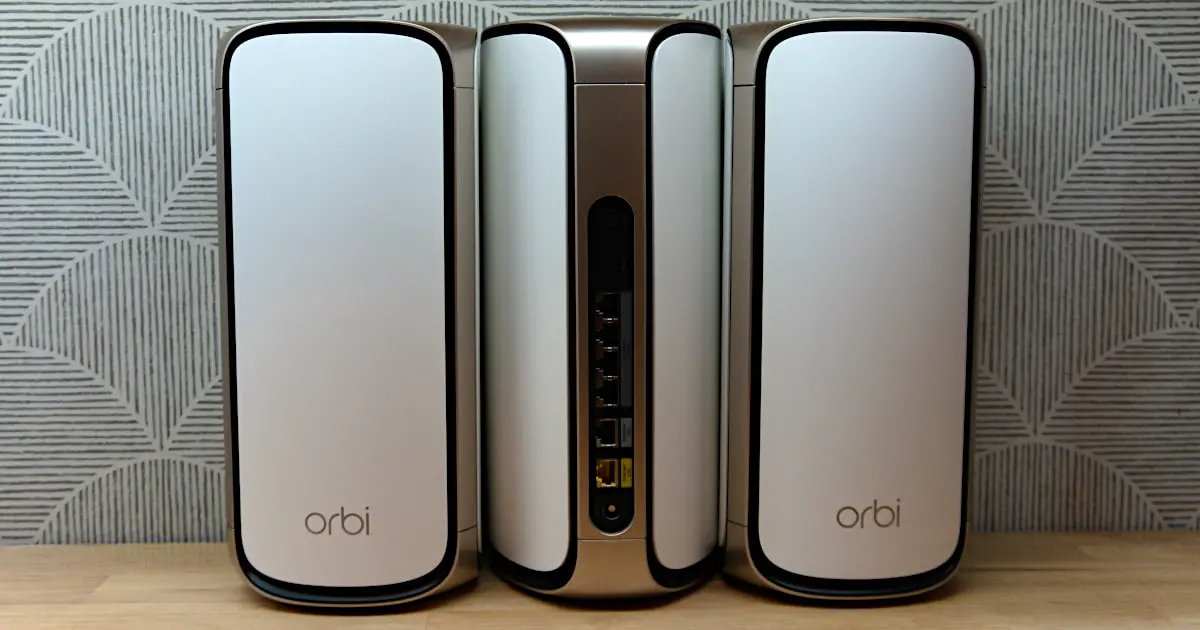The Best Gaming Routers in 2024
We tested a handful of gaming routers to see which is the best your money can buy.
Jul 22, 2024 | Share
Equipment Guides, FAQ
-
Best overallASUS ROG Rapture GT-AX11000
- $367.29*
- Customizable RGB logo
- Free parental controls
- Annoying antennas
-
Best for budgetsASUS RT-AX68U
- $138.28*
- Mobile gaming mode
- Free security
- No multi-gig internet
-
Best for speedMSI RadiX GRAXE66
- $144.99*
- Lighted antennas
- MSI device priority
- Frustrating management
-
Best for featuresNETGEAR Nighthawk XR1000
- $179.26*
- Best gaming interface
- Useful gaming tools
- Subscription-locked features
-
Best for wiredTP-Link Archer AX11000
- $289.95*
- Lots of wired networking
- Link aggregation
- No real gaming tools
*Amazon.com prices (as of 7/22/24 9:50 MST). Read full disclaimer.
Our pick: Which gaming router is best?
Of all the gaming routers we’ve tested to date, the ASUS ROG Rapture GT-AX11000 is our favorite. It checks all the right boxes in both features and speeds based on our tests, making it a great choice for gamers and non-gamers alike. There’s even a little extra bling for gamers with other ASUS ROG products to appreciate.
How we test routers
We vigorously test routers to see how well they stack up against the competition in speed and range. We also evaluate the setup process and dig into the web and mobile apps to see if they’re easy or difficult to use. Check out our methodology section for more information.
The 5 best gaming routers
- Best overall: ASUS ROG Rapture GT-AX11000
- Best for budgets: ASUS RT-AX68U
- Best for speed: MSI RadiX GRAXE66
- Best for features: NETGEAR Nighthawk XR1000
- Best for wired: TP-Link Archer Ax11000
Compare gaming router speeds and prices
| Model | Max throughput | Tested speed @ 40 ft.† | Price* | Order online | |
|---|---|---|---|---|---|
| Best overall | ASUS ROG Rapture GT-AX11000 | 11,000Mbps | 642Mbps | $367.29 | View on Amazon |
| Best for budgets | ASUS RT-AX68U | 2,700Mbps | 567Mbps | $138.28 | View on Amazon |
| Best for speed | MSI RadiX GRAXE66 | 6,600Mbps | 649Mbps | $144.99 | View on Amazon |
| Best for features | NETGEAR Nighthawk XR1000 | 5,400Mbps | 534Mbps | $179.26 | View on Amazon |
| Best for wired | TP-Link Archer AX11000 | 11,000Mbps | 692Mbps | $289.95 | View on Amazon |
*Amazon.com prices (as of 7/22/24 9:50 MST). Read full disclaimer.
† Speed recorded using a Wi-Fi 6 client and an 80 MHz channel.
What should you look for in a gaming router?
Manufacturers generally mark specific routers as gaming routers if they’re designed to support gaming specifically. There’s always something that makes these routers stand out among all the other non-gaming ones, like custom lighting and built-in gaming tools. Some even sync with other products. Keep an eye out for this terminology and the associated features if a standard router just can’t suffice in your gaming arsenal.
On top of that, we suggest finding a router with three bands, a high stream count, and maybe even a long row of Ethernet ports if you prefer wired connections to the internet for gaming. Wi-Fi 6 or newer is best if you need good wireless speeds.
Do you have the best internet plan to go with your gaming router?
We suggest going with Verizon’s fiber internet for the best gaming online, as our tests show it has the lowest latency. Enter your zip code below to see what’s available to you.
Best overall—ASUS ROG Rapture GT-AX11000
 |
|
One of the best gaming routers on the planet |
|
Score:4.1out of 5 |
The GT-AX11000 is a true gaming router, providing actual gaming tools and customizable RGB lighting. It’s definitely not cheap, but you get a lot of bang for the buck, even if you’re not a gamer. |
| Pros | Cons |
|
|
Price: $367.29*
*Amazon.com price (as of 7/22/24 9:50 MST). Read full disclaimer.
Expand for product details and ratings
| Category | Score* | Summary |
| Performance | 4 | Has speeds comparable to other gaming routers at this price, based on tests. |
| Features | 5 | Includes TP-Link’s free HomeCare security suite, a few gaming tools, and more. |
| Design | 4 | Packs three bands, multi-gig internet support, and Aura Sync support. |
| Setup | 4 | Takes a little longer to set up due to the extra features you won’t find on other routers. |
| Ease of use | 4 | Provides a better web interface than the ASUS Router app layout. |
*out of 5 points
What we like about it: The GT-AX11000 is one of the few gaming routers we’ve tested that actually has gaming tools. It’s loaded with good non-gaming stuff too, along with some decent up-close and long-range tested speeds.
What we wish it did better: The antennas on our test unit were a pain. Some refused to stand upright over time, which can cause problems for long-range Wi-Fi transmissions.
Why do we recommend it? The GT-AX11000 is a great router for anyone, not just gamers. Sure, it’s a pretty penny, but there’s so much to love with the GT-AX11000 that it’s hard to overlook. Multi-gig internet support, VPN tools, and actual gaming tools make it a worthwhile investment.
Tested speeds at a glance
| 5 GHz max speed | 2 feet | 40 feet | 120 feet |
| 1,200 | 848 | 642 | 260 |
* Speeds in megabits per second (Mbps) using a Wi-Fi 6 client and an 80 MHz channel.
| Wi-Fi specs | Wired specs |
|
|
Best for budgets—ASUS RT-AX68U
 |
|
A non-gaming router with a cool mobile gaming perk |
|
Score:4.2out of 5 |
The RT-AX68U isn’t specifically a gaming router, but it’s a good candidate for mobile gaming. It has other perks too, like free security and VPN tools. |
| Pros | Cons |
|
|
Price: $138.28*
*Amazon.com price (as of 7/22/24 9:50 MST). Read full disclaimer.
Expand for product details and ratings
| Category | Score* | Summary |
| Performance | 4 | Keeps up with other routers sold at the same price. |
| Features | 5 | Includes a mobile gaming mode, free security, and more. |
| Design | 4 | Supports link aggregation and dual-internet connections. |
| Setup | 5 | Has one of the fastest setups we’ve experienced to date. |
| Ease of use | 4 | Presents a better user-friendly experience in the ASUS Router app than the web interface. |
*out of 5 points
What we like about it: Technically, the RT-AX68U isn’t a gaming router, but you can enable a mobile gaming mode within the ASUS Router app. It has loads of other non-gaming goodies too and good speeds for a router sold at this price based on our tests.
What we wish it did better: The web interface and mobile app need a unified experience to reduce user confusion as they switch between the two.
Why do we recommend it? The RT-AX68U works as a decent gaming router if you’re on a tight budget. There’s a gaming mode you can enable, but that’s it. Still, there’s plenty of other non-gaming features to love here, from the VPN tools to free parental controls.
Tested speeds at a glance
| 5 GHz max speed | 2 feet | 40 feet | 120 feet |
| 1,200 | 848 | 567 | 251 |
* Speeds in megabits per second (Mbps) using a Wi-Fi 6 client and an 80 MHz channel.
| Wi-Fi specs | Wired specs |
|
|
Best for speed—MSI RadiX GRAXE66
 |
|
An eye-catching solution for Windows gamers |
|
Score:4.5out of 5 |
The RadiX GRAXE66 is one of the best gaming routers we’ve ever tested. But you get the most fun out of it if you’re a Windows gamer with other MSI products. |
| Pros | Cons |
|
|
Price: $144.99*
*Amazon.com price (as of 7/22/24 9:50 MST). Read full disclaimer.
Expand for product details and ratings
| Category | Score* | Summary |
| Performance | 5 | Surpasses other tested gaming routers at close range. |
| Features | 4 | Packs a BitTorrent client, an OpenVPN server, and more. |
| Design | 5 | Includes multi-gig connectivity and the new 6 GHz connection. |
| Setup | 4 | Has a quick and painless setup for most users. |
| Ease of use | 3 | Requires three interfaces to fully manage the router. |
* out of 5 points.
What we like about it: The RadiX GRAXE66 has great speeds based on our tests, averaging 888Mbps at close range and 258Mbps at 120 feet. We also clocked a 1,530Mbps up-close average using a 160 MHz channel on the 6 GHz band. Other callouts include multi-gig internet support, customizable lighting, and a built-in BitTorrent client.
What we wish it did better: It lacks lighting controls in the web interface, so Linux and Mac gamers can’t customize the colors and effects.
Why do we recommend it? The RadiX GRAXE66 has stellar performance based on our tests. The colored lighting is rather neat too if you’re into that sort of thing, plus it can prioritize traffic from other MSI PCs and hardware. There are also other non-gaming callouts, including basic parental controls and a built-in BitTorrent client.
Tested speeds at a glance
| 5 GHz max speed | 2 feet | 40 feet | 120 feet |
| 1,200 | 888 | 649 | 258 |
* Speeds in megabits per second (Mbps) using a Wi-Fi 6 client and an 80 MHz channel.
| Wi-Fi specs | Wired specs |
|
|
Best for features—NETGEAR Nighthawk XR1000
 |
|
A decent gaming router with an excellent web interface |
|
Score:3.6out of 5 |
The Nighthawk XR1000 has the best web interface in town plus a few gaming features and ad blocking. But it locks some features behind a subscription, so buyers beware. |
| Pros | Cons |
|
|
Price: $179.26*
*Amazon.com price (as of 7/22/24 9:50 MST). Read full disclaimer.
Expand for product details and ratings
| Category | Score* | Summary |
| Performance | 4 | Provides great speeds for the price based on our speed tests. |
| Features | 3 | Locks premium features behind the NETGEAR Armor subscription. |
| Design | 3 | Lacks link aggregation and multi-gig internet support. |
| Setup | 2 | Prompts a subscription nag and a video tutorial even before you log in. |
| Ease of use | 5 | Presents the coolest app-based web interface we’ve ever seen. |
*out of 5 points
What we like about it: The XR1000 performed like most Wi-Fi 6 routers at this price, testing with an 847Mbps average up close and a 275Mbps average at 120 feet. You get a few real gaming tools like native WTFast support (unlike some other gaming routers) along with an ad-blocker and VPN server.
What we wish it did better: Parents wanting to manage their kids’ online activities need to look elsewhere, as there are no parental controls to be had here.
Why do we recommend it? It’s not quite as loaded as the ASUS ROG Rapture GT-AX11000, but this Nighthawk router has the best web interface (DumaOS) we’ve seen on a router. Plus, it has a few good perks too, like real gaming tools, ad blocking, and a built-in VPN client.
Tested speeds at a glance
| 5 GHz max speed | 2 feet | 40 feet | 120 feet |
| 1,200 | 847 | 534 | 275 |
* Speeds in megabits per second (Mbps) using a Wi-Fi 6 client and an 80 MHz channel.
| Wi-Fi specs | Wired specs |
|
|
Best for wired—TP-Link Archer AX11000
 |
|
A great centerpiece for all your wired gaming devices |
|
Score:4out of 5 |
The Archer AX11000 is one of our favorite routers thanks to its multi-gig connectivity, free features, and plentiful wired ports. But it lacks real gaming tools. |
| Pros | Cons |
|
|
Price: $289.95*
*Amazon.com price (as of 7/22/24 9:50 MST). Read full disclaimer.
Expand for product details and ratings
| Category | Score* | Summary |
| Performance | 4 | Has great up-close speeds and incredible range based on our tests. |
| Features | 4 | Packs free security, parental controls, a VPN server, and mesh networking support. |
| Design | 4 | Includes eight Gigabit Ethernet ports, link aggregation, and a 2.5Gbps internet port. |
| Setup | 4 | Needs separate Basic and Advanced setups so novice users get up and running quickly. |
| Ease of use | 4 | Displays the best web interface of all the TP-Link routers we’ve tested. |
*out of 5 points
What we like about it: The Archer AX11000 is one of our all-time favorite routers. It has excellent tested speeds up close and at longer ranges. Plus, it’s fully loaded under the hood with free security and parental controls, mesh networking support, and more.
What we wish it did better: The Archer AX11000 has a game-centric interface but no unique gaming tools like a few others on this list.
Why do we recommend it? The Archer AX11000 offers great megabit-per-dollar value. It has great speeds complemented by a great set of features like free security and mesh networking. It’s also fully outfitted for wired connectivity with eight Ethernet ports and multi-gig internet support.
Tested speeds at a glance
| 5 GHz max speed | 2 feet | 40 feet | 120 feet |
| 1,200 | 860 | 692 | 282 |
* Speeds in megabits per second (Mbps) using a Wi-Fi 6 client and an 80 MHz channel.
| Wi-Fi specs | Wired specs |
|
|
Gaming router specs and features
Technically, you can use any router to play games locally or online. However, our focus here is on routers designed specifically for gaming. Here are a few things you should keep in mind when you shop for a gaming router.
Gaming tools
While any manufacturer can dress up a router and call it a gaming product, few routers actually include custom tools for gaming.
NETGEAR’s Geo-Fencing tool on the XR1000 is a great example of a tool designed specifically for gamers—it allows you to limit your connections to gaming servers within a custom shape you draw. The Ping Heatmap tool allows you to ping specific game servers to find the one with the lowest latency.
Ports
Consider a router with lots of Ethernet ports to get the best latency-free connection possible. Gigabit Ethernet has sustained speeds of around 940Mbps up to 328 feet when you have one of the best Ethernet cables connected, while a 2.5Gbps Ethernet (2.5GbE) port maxes out at around 2,370Mbps. Link aggregation allows you to pair two Gigabit Ethernet ports together for a multi-gig connection too.
Bling
Bling isn’t a requirement, but it sure makes a statement. Alienware, ASUS, HP, MSI—they all push some type of bling, so everyone knows you’re a gamer. Even the ASUS ROG phone shines the RGB logo on the back like an eye. Why shouldn’t your gaming router sparkle and dazzle onlookers too?
Wi-Fi 6 and newer
You should choose a router with Wi-Fi 6 or newer if you want the best wireless speeds. With Wi-Fi 6, you can get real-world sub-2Gbps speeds using a 160 MHz channel on the 5 GHz band (if you’re lucky). But you probably have a better chance of hitting those speeds on Wi-Fi 6E routers using a 160 MHz channel on the new 6 GHz band.
Other general router stuff
Radios – We recommend routers with three Wi-Fi radios, as they generally divide the 5 GHz spectrum across two radios, so your devices aren’t crowding a single 5 GHz channel. Wi-Fi 6E swaps out one of the two 5 GHz radios with one that accesses the new 6 GHz band.
Streams – The more streams you have, the better. Typically, a router’s max throughput dictates how many devices it can handle in any given second. You want a high stream count and high bandwidth to reduce the amount of time your devices must wait to transmit and receive data.
Antennas – The more antennas you have, the better. Ideally, you want external antennas if you need a long range or internal ones if you prefer multi-floor connectivity. Multiple antennas are also used for Beamforming and MU-MIMO technology.
Our verdict
The ASUS ROG Rapture GT-AX11000 is our favorite gaming router, hands down. It has everything gamers and non-gamers could possibly need, including free security, printer sharing, and VPN connectivity. It even has gaming tools like user profiles, real-time ping rates, and RGB customization and synchronization with other ROG products. It has great speeds based on our tests too, making it one of the best routers you can get.
Methodology
We test router speed by setting up each router in an office and connecting it to a local test server. Then, we transmit test data between our wireless devices and the server, taking numerous measurements to account for fluctuations in Wi-Fi speeds.
The first tests occur close to the router, without obstructions—so the Wi-Fi is as strong and fast as it’s gonna get. We repeat the process straight out at 10, 20, and 30 feet, with only a glass door obstructing our view of the router. The same glass door and an exterior door blocks our path when we test outside at 40 and 50 feet.
We also run tests in a hallway to the left of the TV room and office—where there’s a glass door, three walls, and an air handler unit blocking our view of the router. The dining room, another testing point, sits to the right of the kitchen, TV room, and office—two walls and a glass door block the path in this test.
To test video streaming, we connect a fast storage device to the router and stream a 4K video to six wireless devices simultaneously—two phones, three tablets, and a laptop—connected to the same wireless band.
Client devices used in testing
| iPhone 12 Pro Max | Google Pixel 3 | |
|---|---|---|
| Wi-Fi specification | Wi-Fi 6 | Wi-Fi 5 |
| Stream configuration | 2 x 2 | 2 x 2 |
| Max 5 GHz speed (AX) | 1,200Mbps | — |
| Max 5 GHz speed (AC) | 866Mbps | 866Mbps |
| Max 2.4 GHz speed (AX) | 195Mbps | — |
| Max 2.4 GHz speed (AC) | 195Mbps | 144Mbps |
Router benchmarks
Here are the average 5 GHz speeds recorded for each router. Wi-Fi speeds fluctuate significantly, so these numbers reflect at least three tests taken at each 10-foot interval.
ASUS ROG Rapture GT-AX11000
| iPhone 12 Pro Max | Google Pixel 3 | |
|---|---|---|
| 2 feet | 848 | 652 |
| 10 feet | 827 | 644 |
| 20 feet | 755 | 529 |
| 30 feet | 729 | 462 |
| 40 feet (porch) | 642 | 308 |
| 120 feet (across street) | 260 | 169 |
* Speeds in megabits per second (Mbps) using an 80 MHz channel.
ASUS RT-AX68U
| iPhone 12 Pro Max | Google Pixel 3 | |
|---|---|---|
| 2 feet | 848 | 665 |
| 10 feet | 796 | 631 |
| 20 feet | 766 | 602 |
| 30 feet | 759 | 518 |
| 40 feet (porch) | 567 | 369 |
| 120 feet (across street) | 251 | 148 |
* Speeds in megabits per second (Mbps) using an 80 MHz channel.
MSI RadiX GRAXE66
| iPhone 12 Pro Max | Google Pixel 3 | |
|---|---|---|
| 2 feet | 888 | 691 |
| 10 feet | 814 | 637 |
| 20 feet | 726 | 522 |
| 30 feet | 701 | 442 |
| 40 feet (porch) | 549 | 301 |
| 120 feet (across street) | 258 | 91 |
* Speeds in megabits per second (Mbps) using an 80 MHz channel.
NETGEAR Nighthawk XR1000
| iPhone 12 Pro Max | Google Pixel 3 | |
|---|---|---|
| 2 feet | 847 | 684 |
| 10 feet | 796 | 659 |
| 20 feet | 747 | 549 |
| 30 feet | 723 | 494 |
| 40 feet (porch) | 534 | 326 |
| 120 feet (across street) | 275 | 122 |
* Speeds in megabits per second (Mbps) using an 80 MHz channel.
TP-Link Archer AX11000
| iPhone 12 Pro Max | Google Pixel 3 | |
|---|---|---|
| 2 feet | 860 | 658 |
| 10 feet | 848 | 645 |
| 20 feet | 768 | 572 |
| 30 feet | 745 | 453 |
| 40 feet (porch) | 692 | 330 |
| 120 feet (across street) | 282 | 175 |
* Speeds in megabits per second (Mbps) using an 80 MHz channel.
Other routers we tested
We tested more than a dozen routers and mesh kits to determine which ones work well for gaming. Here are other tested models we do and don’t recommend.
Other routers we recommend for gaming
| Model | Summary | Price* | Shop online |
|---|---|---|---|
| TP-Link Archer AX6000 | Has one less band and fewer streams than the AX11000 model. | $189.99 | View on Amazon |
| TP-Link Archer AX90 | Packs three Wi-Fi bands and lots of speed to handle a busy home. | $269.99 | View on Amazon |
*Amazon.com prices (as of 7/22/24 9:50 MST). Read full disclaimer.
Other routers we don’t recommend for gaming
| Model | Summary | Price* | More details |
|---|---|---|---|
| TP-Link Archer A10 | Handles four devices without interruption but is as basic as you can get. | $59.99 (used) | View on Amazon |
| TP-Link Archer AX20 | It’s a step up in speed from the A10, but you’ll see more congestion. | $84.99 | View on Amazon |
*Amazon.com prices (as of 7/22/24 9:50 MST). Read full disclaimer.
FAQ about gaming routers
What are Aura RGB and Aura Sync?
What is WTFast?
What is DumasOS?
What type of free security does Trend Micro provide?
Disclaimer
Amazon.com Prices as of 7/22/24 9:50 MST. Product prices and availability are accurate as of the date/time indicated and are subject to change. Any price and availability information displayed on Amazon.com at the time of purchase will apply to the purchase of this product. HighSpeedInternet.com utilizes paid Amazon links.
CERTAIN CONTENT THAT APPEARS ON THIS SITE COMES FROM AMAZON. THIS CONTENT IS PROVIDED ‘AS IS’ AND IS SUBJECT TO CHANGE OR REMOVAL AT ANY TIME.
Author - Kevin Parrish
Kevin Parrish has more than a decade of experience working as a writer, editor, and product tester. He began writing about computer hardware and soon branched out to other devices and services such as networking equipment, phones and tablets, game consoles, and other internet-connected devices. His work has appeared in Tom’s Hardware, Tom's Guide, Maximum PC, Digital Trends, Android Authority, How-To Geek, Lifewire, and others. At HighSpeedInternet.com, he focuses on network equipment testing and review.
Editor - Rebecca Lee Armstrong
Rebecca Lee Armstrong has more than six years of experience writing about tech and the internet, with a specialty in hands-on testing. She started writing tech product and service reviews while finishing her BFA in creative writing at the University of Evansville and has found her niche writing about home networking, routers, and internet access at HighSpeedInternet.com. Her work has also been featured on Top Ten Reviews, MacSources, Windows Central, Android Central, Best Company, TechnoFAQ, and iMore.

